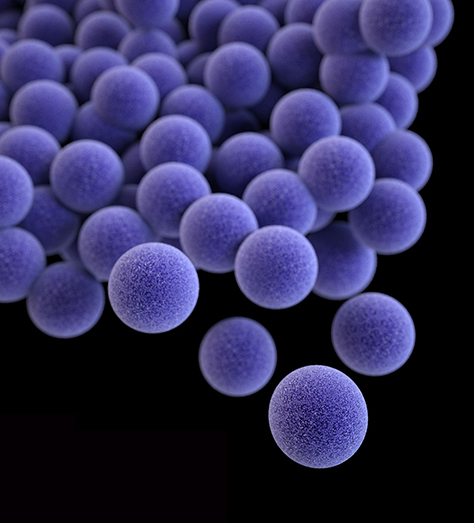How Bacteria Control Their Size

CDC Methicillin-resistant Staphylococcus aureus, or MRSA, are so uniform in size they look like they were made in a factory. How do the bacteria manage to keep their size so uniform?
Scientists have traditionally studied bacteria in large numbers, not individually. Working with tens of millions of cells in a culture flask, they tracked their growth by looking at how much the cells dimmed light passing through a tube.
Using this method, scientists learned that populations of bacteria grow exponentially, doubling in mass at regular time intervals. And so, not unreasonably, they assumed that individual cells would do the same, dividing only when they have doubled in size.
In the Dec. 24 online issue of Current Biology a group of scientists led by Suckjoon Jun of the University of California-San Diego, and including Petra Levin, PhD, associate professor of biology in Arts & Sciences at Washington University in St. Louis, report that this hypothesis was incorrect.
“Even though on average it is true that mass doubles,” Levin said, “when you look at individual cells it becomes apparent that something else is going on.” Instead of examining populations of cells growing in a flask or test tube, the Jun group instead used a microfluidics device called a “mother machine” to follow hundreds of thousands of individual cells from birth to division.
They found that rather than doubling in size every generation, each cell added the same volume (or mass; the term reflects the measurement technique). Crucially a cell that was small added the same volume as a cell that was large.
Why is this the rule? “Although this might seem counter-intuitive, over many generations this rule ensures that cells in a population maintain a constant size,” Levin said.
“This study really shows how new technologies, in this case the development of the ‘mother machine’ to visualize single bacteria in real time, can lead to new and unexpected answers to old problems,” Levin said.
“Pinning down the growth rule is important,” she added, “because it provides clues to the underlying biochemical mechanism that ultimately controls growth. The mechanism is probably essential — or nearly so — and thus good target for new antimicrobials.”
“Surprisingly little is known about biological size control in general,” Levin said.
“Why are we the size we are? Why are our organs the size they are? Why are the cells in those organs a stereotypical size? What regulates that?”
“We take all this for granted,” she said, “but really, very little of it is understood.”
Contact Information
Diana Lutz
Senior Science Editor
dlutz@wustl.edu
Phone: 314-935-5272
Media Contact
More Information:
http://www.wustl.eduAll latest news from the category: Life Sciences and Chemistry
Articles and reports from the Life Sciences and chemistry area deal with applied and basic research into modern biology, chemistry and human medicine.
Valuable information can be found on a range of life sciences fields including bacteriology, biochemistry, bionics, bioinformatics, biophysics, biotechnology, genetics, geobotany, human biology, marine biology, microbiology, molecular biology, cellular biology, zoology, bioinorganic chemistry, microchemistry and environmental chemistry.
Newest articles

NASA: Mystery of life’s handedness deepens
The mystery of why life uses molecules with specific orientations has deepened with a NASA-funded discovery that RNA — a key molecule thought to have potentially held the instructions for…

What are the effects of historic lithium mining on water quality?
Study reveals low levels of common contaminants but high levels of other elements in waters associated with an abandoned lithium mine. Lithium ore and mining waste from a historic lithium…

Quantum-inspired design boosts efficiency of heat-to-electricity conversion
Rice engineers take unconventional route to improving thermophotovoltaic systems. Researchers at Rice University have found a new way to improve a key element of thermophotovoltaic (TPV) systems, which convert heat…



